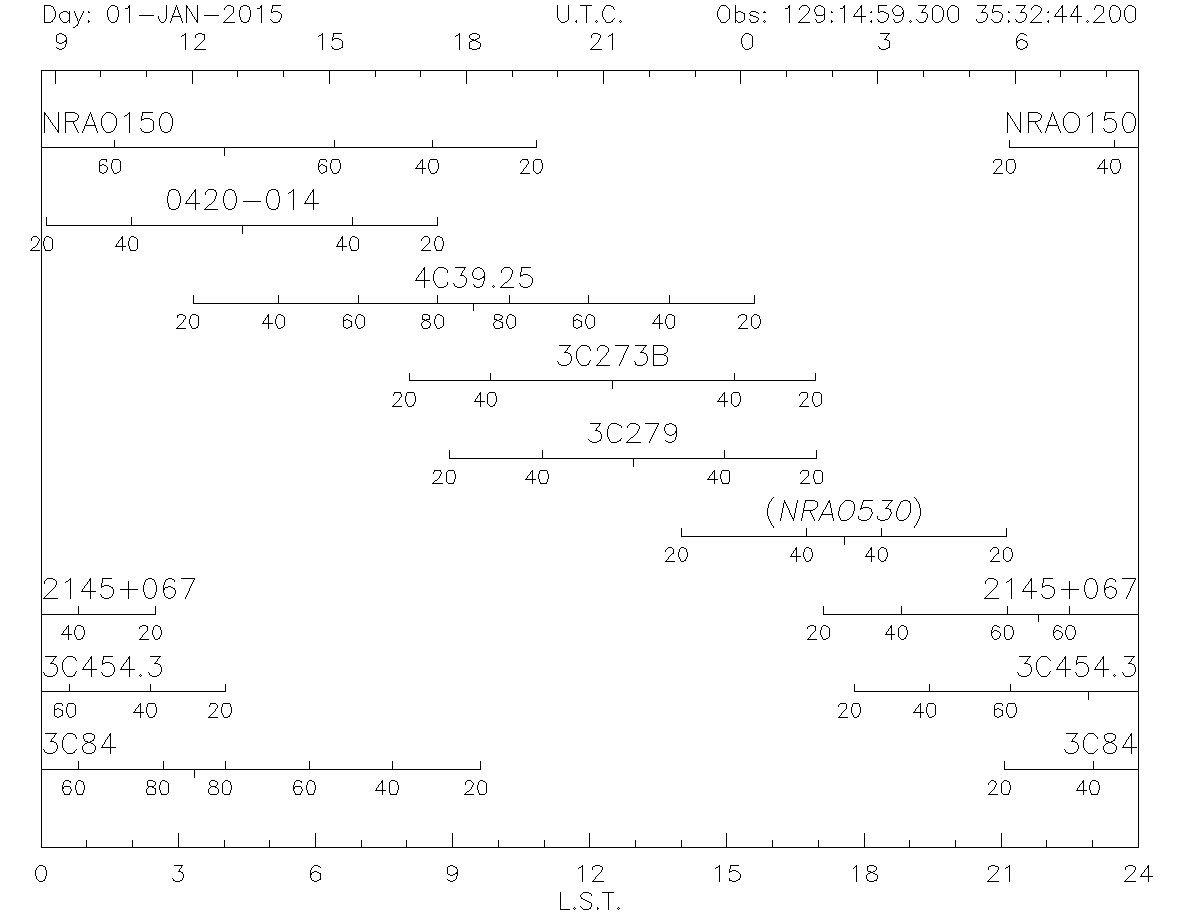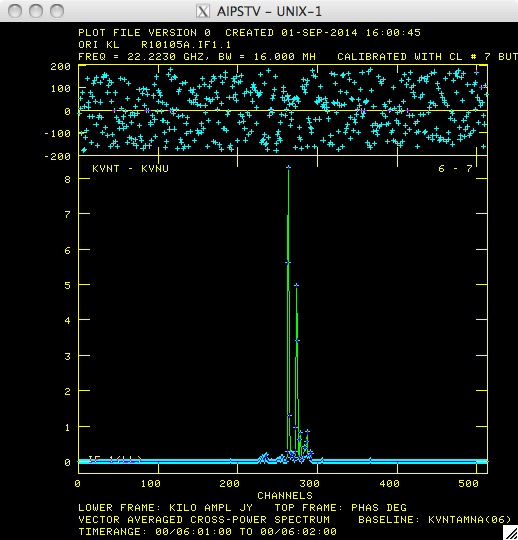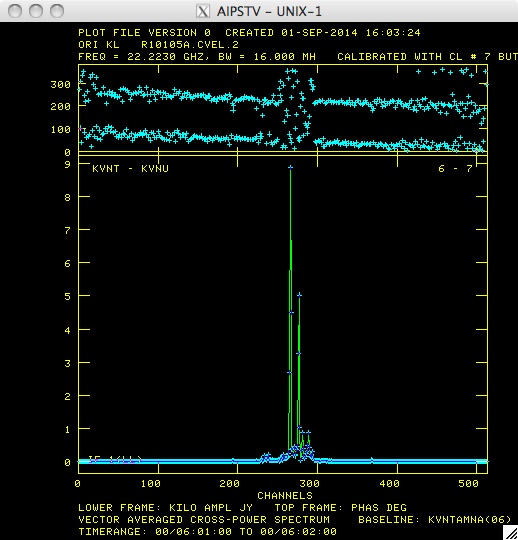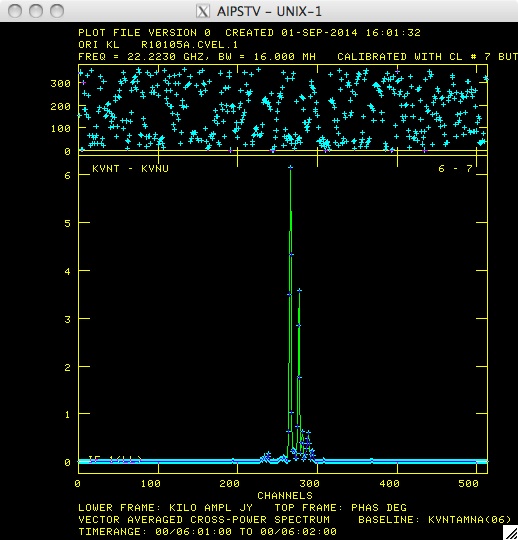Notice to KaVA Users
We would like to inform you about the KaVA operation and user support as follows.
- Three new email accounts are created.
- kjcc@kasi.re.kr: correlated data distribution and correlation related requests.
- kavaobs@kasi.re.kr: KaVA observation related, schedule submission → redirection to Shibata-san, Jeong-Sook Kim & Byun san
- kavahelp@kasi.re.kr: KaVA user support in general → redirection to KaVA UST members (Hirota-san and Taehyun)
- Schedule submission: We request PIs to specify your correlation parameters at the beginning of the vex file for proper correlation processing. In particular, PIs who request for sub-array or dual-beam observations for KaVA should provide a frequency matching table for the correct correlation.
- Correlation and Data Validation/Distribution: After two weeks later of a correlated data distribution to PIs, disk modules which contains raw observing data can be recycled without notice. Therefore, PIs should investigate the correlated output carefully. For re-correlation or raw data keeping of the data, PI should provide adequate evidence in order to justify his/her request. If there is an issue related to correlated data, PI should consult a support scientist first or an email (kjcc@kasi.re.kr), not to ask KJCC members directly.
- Policy of Recovery Observation (open-use observation only): If an open-use observation has more than one missing stations due to system trouble and/or very severe weather condition (e.g. strong wind by typhoon), PI can request recovery observation after checking the correlated data by the deadline of KaVA call for proposals within one year from the delivery of the correlated data. Pi must resubmit the proposal which must include the necessity of recovery observation. The KaVA combined TAC will consider the time allocation of the recovery observations for the next season.
KaVA Observing Preparation
General Information
For the accepted proposals, users are requested to prepare the observing schedule file, at least one week before the observation. The observer who is not familiar with KaVA system is recommended to consult with KaVA user support team (kavahelp@kasi.re.kr) to prepare schedules. KaVA operation & support members take full responsibility for observation and correlation process.
Observation
The users are asked to submit a VEX file two weeks before the observation to kavaobs@kasi.re.kr. Observations will be performed by KaVA operators so that users will not be asked to take part in observations.
Correlation
The correlation process will be carried out by Daejeon correlator at KJCC (Korea-Japan Correlation Center). The correlated data can be downloadable via FTP and its address will be given to the PI via email. Then, users are asked to examine the correlated data and if there is some problem, you can request re-correlation within a month after the correlation. In this case, you should provide the details of your problem clearly. In principle, the raw data used for observations will be recycled one month after the correlation.
Data Rights and Archiving
The PIs will have exclusive access to the data obtained for 18 months after the correlation. This policy is applied to each observation, even if the proposal comprises multi epoch observations. After this exclusive period, the data will be publicly accessible.
Schedule Preparation
1. VEX Preparation
You can download the KaVA VEX example file from here and modify them for your observation. More sample vex files for a specific observation case are also available in the following table. The schedule submission should be done by a standalone vex file including calibration procedures (e.g. sky dipping, hot/cold calibration, focusing, pointing etc.). The correlation parameters must be clearly specified as an example VEX file.
| KaVA C2 mode observation (continuum) | k17ic02a.vex | k17ic02a.key |
| KaVA K-band astrometric observation | k18ns01e_KVN.vex | k18ns01e_VERA.vex |
| KaVA+TM 22GHz C4 mode observation (continuum) | samplevex.kava22c4.vex | samplevex.tm22c4.vex |
| KaVA+TM 43GHz C4 mode observation (continuum) | samplevex.kava43c4.vex | samplevex.tm43c4.vex |
| KaVA+TM 22GHz C5 mode observation (continuum) | samplevex.kava22c5.vex | samplevex.tm22c5.vex |
| KaVA+TM 43GHz C5 mode observation (continuum) | samplevex.kava43c5.vex | samplevex.tm43c5.vex |
2. Frequency Setup (DAS setup)
At present, following observing modes are available. Please refer to the KaVA status report for more details.
- Frequency band: K (22GHz), Q (43GHz) bands (both in LHCP only)
- Recording mode: 1024 Mbps (Mark5B for KVN, DIR2000/OCTADISK for VERA)
- Filtering mode: 16MHz bandwidth x 16 channels
3. Check List of Scheduling
Following items are the check list for the success of VLBI observation.
- Good fringe finders are essential to remove large delay errors between the real observation and the correlation model. At least two fringe finder scans must be scheduled at the beginning and the end of your observation with the scan length of 5 minutes for a successful fringe search. It is highly recommended to observe fringe finder sources every 1~2 hours.
- You must specify the fringe finder sources and correlation parameters on your VEX files explicitly. Please refer to the VEX template for details.
- Compact and strong source are suitable for fringe finders with well-known source positions at your observing frequency. If your target sources are quite strong, you may not need to observe a fringe finder. Following sources are recommended.
- 22GHz (> 2Jy): NRAO150, 0420-014, 4C39.25, 3C273, 3C279, NRAO530, 2145+067, 3C454.3, 3C84
- 43GHz (> 4Jy): NRAO150, 3C279, 3C345
Source-Elevation plot of several fringe finders

Fringe Finder Sources
For a phase referencing observation or calibration purposes, a phase calibrator close to your target source is necessary. List of VLBI calibrators are available as follows.
- The VLBA Calibrator List: http://www.vlba.nrao.edu/astro/calib/vlbaCalib.txt
- Astrogeo Center: http://astrogeo.org
Tsys measurements and Pointing correction
- Tsys measurements for each KaVA antenna is performed by R-Sky method. Hot load is inserted on the front of the feed-horn for 30 seconds before or after each scan (no Tsys measurements during scans). You need to split a consecutive integration into multiple short scans if you would like to track the time variation of Tsys.
- It is recommanded to perform a pointing correction every hour for KVN antennas. Please insert 2 minutes gap for it. Five pointing for spectral line sources and cross-scan for continuum sources correction are applied.
Data Analysis
1. Documentations of KaVA data analysis
Note that the AIPS Cookbook is a useful general guide for calibration and imaging of VLBI data.
http://www.aips.nrao.edu/cook.html : AIPS Cookbook
Hands-on analysis documentation of VLBI data is available in the following URL.
http://veraserver.mtk.nao.ac.jp/VERA/kurayama/WinterSchool/TableOfContents.htm
Several documentations related the KaVA data analysis would be helpful.
- KJtutorial12_sss.pdf: Introduction of AIPS
- AIPS-flow.pdf : Example of AIPS flow chart
- AIPS_Task_INDEX_ver4.pdf : AIPS task Index
2. Tips for KaVA data analysis
For some parts of data analysis, KaVA would require special treatment as below :
2.1 Amplitude calibration
For amplitude calibration of KaVA data, KaVA provides the ANTAB files to PIs. The ANTAB file contains the gain curves for each antenna, and system temperature taken during the observation. You will obtain the TY and GC tables, loading the ANTAB file by running the AIPS task "ANTAB".
2.2 Parallactic angle correction
Time variation of a parallactic angle of a source occurs for the receiving system mounted in an azimuth-elevation mounted telescope and generates a phase rotation. This phase rotation can be corrected with the AIPS task "CLCOR" with the adverb of OPCODE='PANG'. In the case of VERA antenna, the field rotator in the receiving room fixes the parallactic angle, and therefore it is not necessary to run "CLCOR" for VERA antennas. But, you have to do this correction for the KVN antennas.2.3 Editing the AN table
The doppler velocity shifts due to the earth's rotation and its motion within the solar system and towards the local standard of rest can be corrected using the AIPS task "CVEL". When the ARRNAM keyword in the AN table is "VLBA", then "CVEL" assumes that all data have been fringe-rotated to the centre of the Earth and determine the velocity correction accordingly. KaVA follows the VLBA and fringe rotates to the Earth center. Thus, the ARRNAM keyword in the AN table has to be "VLBA". Please run the task "TABED" and give "VLBA" to the ARRNAME keyword in the AN table.2.4 Gibbs ringing effects around a bright and narrow spectral line
KaVA contains comparatively-short baselines (~300 km) as a VLBI array, and various Gibbs ringing effects could sometimes be seen in the case of the bright narrow spectral features. It is strongly recommended to smooth such spectral features when you correct the velocity shifts, by running the AIPS task "CVEL" with the adverb of APARM(9)>1.

r10105a_bf_cvl: Before CVEL

r10105a_aft_cvl_nosmooth: After CVEL with APARM(9)=0 (no smoothing)

r10105a_aft_cvl_smooth: After CVEL with APARM(9)=2 (smoothing)
Figures : Water maser lines in Orion KL in the Tamna-Ulsan baseline
Contact Persons
The users can contact any staff member of the KaVA by E-mail
| Name | E-mail address | Related Field |
|---|---|---|
| T. Jung | thjung@kasi.re.kr | User Support Team (UST) |
| T. Hirota | tomoya.hirota@nao.ac.jp | User Support Team (UST) |
| Name | E-mail address | Related Field |
|---|---|---|
| H. Kobayashi | hideyuki.kobayashi@nao.ac.jp | Project Director, Total systems |
| K. M. Shibata | k.m.shibata@nao.ac.jp | Operation, Schedule management, Antenna site in general |
| T. Jike | takaaki.jike@nao.ac.jp | Geodetic measurement |
| T. Hirota | tomoya.hirota@nao.ac.jp | Performance for each antenna |
| M. Honma | mareki.honma@nao.ac.jp | Phase calibration, Data analysis |
| Name | E-mail address | Related Field |
|---|---|---|
| D. Y. Byun | bdy@kasi.re.kr | Array Operation and System Specification |
| S. S. Lee | sslee@kasi.re.kr | VLBI Performance |
| T. Jung | thjung@kasi.re.kr | Observation Preparation and Data Analysis |
| D. G. Roh | dgroh@kasi.re.kr | Correlation |